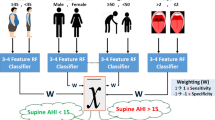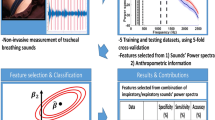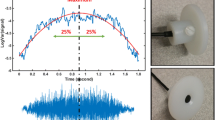Abstract
Purpose
The diagnosis of obstructive sleep apnea (OSA) relies on time-consuming and complicated procedures which are not always readily available and may delay diagnosis. With the widespread use of artificial intelligence, we presumed that the combination of simple clinical information and imaging recognition based on facial photos may be a useful tool to screen for OSA.
Methods
We recruited consecutive subjects suspected of OSA who had received sleep examination and photographing. Sixty-eight points from 2-dimensional facial photos were labelled by automated identification. An optimized model with facial features and basic clinical information was established and tenfold cross-validation was performed. Area under the receiver operating characteristic curve (AUC) indicated the model’s performance using sleep monitoring as the reference standard.
Results
A total of 653 subjects (77.2% males, 55.3% OSA) were analyzed. CATBOOST was the most suitable algorithm for OSA classification with a sensitivity, specificity, accuracy, and AUC of 0.75, 0.66, 0.71, and 0.76 respectively (P < 0.05), which was better than STOP-Bang questionnaire, NoSAS scores, and Epworth scale. Witnessed apnea by sleep partner was the most powerful variable, followed by body mass index, neck circumference, facial parameters, and hypertension. The model’s performance became more robust with a sensitivity of 0.94, for patients with frequent supine sleep apnea.
Conclusion
The findings suggest that craniofacial features extracted from 2-dimensional frontal photos, especially in the mandibular segment, have the potential to become predictors of OSA in the Chinese population. Machine learning–derived automatic recognition may facilitate the self-help screening for OSA in a quick, radiation-free, and repeatable manner.





Similar content being viewed by others
Data availability
The datasets generated from original facial photos in the current study are available from the corresponding author on reasonable request.
Abbreviations
- AHI:
-
Apnea-hypopnea index
- AUC:
-
Area under curve
- BMI:
-
Body mass index
- OSA:
-
Obstructive sleep apnea
- PM:
-
Portable monitoring
- PSG:
-
Polysomnography
- ROC:
-
Receiver operating characteristic curve
References
Mannarino MR, Di Filippo F, Pirro M (2012) Obstructive sleep apnea syndrome. Eur J Intern Med 23:586–593
Sutherland K, Lee RWW, Cistulli PA (2012) Obesity and craniofacial structure as risk factors for obstructive sleep apnoea: impact of ethnicity. Respirology 17:213–222
Xu L, Keenan BT, Wiemken AS, Chi L, Staley B, Wang Z, Wang J, Benedikstdottir B, Juliusson S, Pack AI, Gislason T, Schwab RJ (2020) Differences in three-dimensional upper airway anatomy between Asian and European patients with obstructive sleep apnea. Sleep 43(5):zsz273
Lee RWW (2010) Differences in craniofacial structures and obesity in Caucasian and Chinese patients with obstructive sleep apnea. Sleep 33(8):1075–1080
Sutherland K, Lee RWW, Chan TO, Ng S, Hui DS, Cistulli PA (2018) Craniofacial phenotyping in Chinese and Caucasian patients with sleep apnea: influence of ethnicity and sex. J Clin Sleep Med 14:1143–1151
Sutherland K, Chapman JL, Cayanan EA, Lowth AB, Wong KKH, Yee BJ, Grunstein RR, Marshall NS, Cistulli PA (2019) Parsing the craniofacial phenotype: effect of weight change in an obstructive sleep apnoea population. Sleep Breath 23:1291–1298
O'driscoll DM, Landry SA, Pham J, Young A, Sands SA, Hamilton GS, Edwards BA (2019) The physiological phenotype of obstructive sleep apnea differs between Caucasian and Chinese patients. Sleep 42(11):zsz186
Neelapu BC, Kharbanda OP, Sardana HK, Balachandran R, Sardana V, Kapoor P, Gupta A, Vasamsetti S (2017) Craniofacial and upper airway morphology in adult obstructive sleep apnea patients: a systematic review and meta-analysis of cephalometric studies. Sleep Med Rev 31:79–90
Sutherland K, Phillips CL, Yee BJ, Grunstein RR, Cistulli AA (2016) Maxillomandibular volume influences the relationship between weight loss and improvement in obstructive sleep apnea. Sleep 39:43–49
Yung-Chuan Liu S (2016) Static craniofacial measurements and dynamic airway collapse patterns associated with severe obstructive sleep apnoea: a sleep MRI study. Clin Otolaryngol 41(6):700–706
Lee RWW (2009) Craniofacial phenotyping in obstructive sleep apnea – a novel quantitative photographic approach. Sleep 32(1):37–45
Sutherland K, Lee RWW, Petocz P, Chan TO, Ng S, Hui DS, Cistulli PA (2016) Craniofacial phenotyping for prediction of obstructive sleep apnoea in a Chinese population. Respirology 21:1118–1125
Remya KJ, Mathangi K, Mathangi DC, Sriteja Y, Srihari R, Govindaraju S, Hillman DR, Eastwood PR (2017) Predictive value of craniofacial and anthropometric measures in obstructive sleep apnea (OSA). Cranio : J Craniomandibular Pract 35:162–167
Huang W-C, Lee P-L, Liu Y-T, Chiang AA, Lai F (2020) Support vector machine prediction of obstructive sleep apnea in a large-scale Chinese clinical sample. Sleep 43(7):zsz295
Myers KA, Mrkobrada M, Simel DL (2013) Does this patient have obstructive sleep apnea?: The Rational Clinical Examination systematic review. JAMA 310:731–741
Kapur VK, Auckley DH, Chowdhuri S, Kuhlmann DC, Mehra R, Ramar K, Harrod CG (2017) Clinical practice guideline for diagnostic testing for adult obstructive sleep apnea: an American Academy of Sleep Medicine Clinical Practice Guideline. J Clin Sleep Med 13:479–504
Kazemi V, Sullivan J (2014) One millisecond face alignment with an ensemble of regression trees. 2014 IEEE Conference on Computer Vision and Pattern Recognition, Columbus, OH, USA. pp. 1867–1874
Coutinho Costa J, Rebelo-Marques A, Machado JN, Gama JMR, Santos C, Teixeira F, Moita J (2019) Validation of NoSAS (neck, obesity, snoring, age, sex) score as a screening tool for obstructive sleep apnea: analysis in a sleep clinic. Pulmonology 25:263–270
Lin S-W, Sutherland K, Liao F-U, Cistulli PA, Chuang L-P, Chou Y-T, Chang C-H, Lee CS, Li LF, Chen NH (2018) Three-dimensional photography for the evaluation of facial profiles in obstructive sleep apnoea. Respirology 23:618–625
Banabilh SM, Suzina AH, Dinsuhaimi S, Samsudin AR, Singh GD (2009) Craniofacial obesity in patients with obstructive sleep apnea. Sleep Breath 13:19–24
Sutherland K, Schwab RJ, Maislin G, Lee RWW, Benedikstdsottir B, Pack AI, Gislason T, Juliusson S, Cistulli PA (2014) Facial phenotyping by quantitative photography reflects craniofacial morphology measured on magnetic resonance imaging in Icelandic sleep apnea patients. Sleep 37:959–968
Tondo P, Dell’Olio F, Lacedonia D, Sabato R, Leccisotti R, Foschino Barbaro MP, Scioscia G (2022) A consumer wearable device for tracking sleep respiratory events. Sleep Breath 2022:Online ahead of print
Holfinger SJ, Lyons MM, Keenan BT, Mazzotti DR, Mindel J, Maislin G, Cistulli PA, Sutherland K, Mcardle N, Singh B, Chen NH, Gislason T, Penzel T, Han F, Li QY, Schwab R, Pack AI, Magalang UJ (2022) Diagnostic performance of machine learning-derived OSA prediction tools in large clinical and community-based samples. Chest 161:807–817
He S, Li Y, Xu W, Han D (2022) Using clinical data to predict obstructive sleep apnea. J Thorac Dis 14:227–237
Gourishetti SC, Taylor R, Isaiah A (2022) Stratifying the risk of cardiovascular disease in obstructive sleep apnea using machine learning. Laryngoscope 132(1):234–241
Espinoza-Cuadros F, Fernandez-Pozo R, Toledano DT, Alcazar-Ramirez JD, Lopez-Gonzalo E, Hernandez-Gomez LA (2015) Speech signal and facial image processing for obstructive sleep apnea assessment. Comput Math Methods Med 2015:489761
Tyan M, Espinoza-Cuadros F, Fernández Pozo R, Toledano D, Lopez Gonzalo E, Alcazar Ramirez JD, Hernandez Gomez LA (2017) Obstructive sleep apnea in women: study of speech and craniofacial characteristics. JMIR mHealth and uHealth 5:e169
Ozdemir ST (2019) Three-dimensional analysis of craniofacial shape in obstructive sleep apnea syndrome using geometric morphometrics. Int J Morphol 37(1):338–343
Wang X, Chen H, Jia L, Xu X, Guo J (2021) The relationship between three-dimensional craniofacial and upper airway anatomical variables and severity of obstructive sleep apnoea in adults. Eur J Orthod 44(1):78–85
Monna F, Ben Messaoud R, Navarro N, Baillieul S, Sanchez L, Loiodice C, Tamisier R, Joyeux-Faure M, Pepin JF (2022) Machine learning and geometric morphometrics to predict obstructive sleep apnea from 3D craniofacial scans. Sleep Med 95:76–83
Acknowledgements
All authors gave final approval of the version to be published and agreed to be accountable for all aspects of the work.
Funding
This study was supported by the National Key Research and Development Program of China (No. 2020YFC2003600). The sponsor had no role in the design or conduct of this research.
Author information
Authors and Affiliations
Corresponding authors
Ethics declarations
Ethics approval
All procedures performed in studies involving human participants were in accordance with the ethical standards of the Ethics Committee of Beijing Anzhen Hospital and with the 1964 Helsinki Declaration and its later amendments or comparable ethical standards.
Informed consent
Informed consent was obtained from all individual participants included in the study.
Conflict of interest
The authors declare no competing interests.
Study registration
This study was registered in the Chinese Clinical Trial Registry (No. ChiCTR-ROC-17011027).
Additional information
Publisher's note
Springer Nature remains neutral with regard to jurisdictional claims in published maps and institutional affiliations.
Supplementary Information
Below is the link to the electronic supplementary material.
Rights and permissions
Springer Nature or its licensor (e.g. a society or other partner) holds exclusive rights to this article under a publishing agreement with the author(s) or other rightsholder(s); author self-archiving of the accepted manuscript version of this article is solely governed by the terms of such publishing agreement and applicable law.
About this article
Cite this article
Chen, Q., Liang, Z., Wang, Q. et al. Self-helped detection of obstructive sleep apnea based on automated facial recognition and machine learning. Sleep Breath 27, 2379–2388 (2023). https://doi.org/10.1007/s11325-023-02846-9
Received:
Revised:
Accepted:
Published:
Issue Date:
DOI: https://doi.org/10.1007/s11325-023-02846-9




